All about the dye shop

Autumn paints nature in colorful colors, but sometimes bright trees and bushes are not enough to brighten up the melancholic autumn mood. An additional source of pleasant emotions at this time of the year is the autumn flowers in the flower beds, which seem to still contain a piece of the warm summer. Pupavka dyeing, or antemis, is one of those colorful plants that, during the onset of cold weather, delight the eye with pretty small flowers.
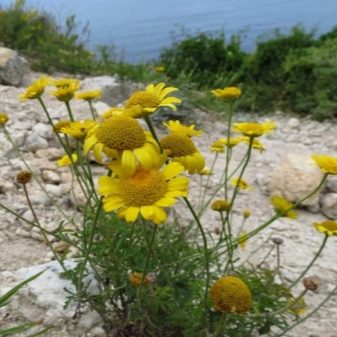
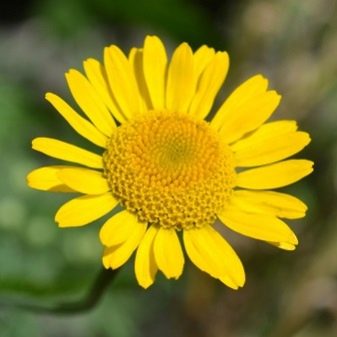
Botanical description
The name of the navel dyeing in Latin is cota tinctoria, or anthemis tinctoria. The perennial plant has many popular names: “yellow flower”, “umbilical plant”, “yellow chamomile”, “golden-bellied plant”, “yellow water” and many others. In the people, such autumn colors are given a name based on the shade of the bud, because it is painted in a bright yellow color, which easily attracts the attention of people. The main name of the dyeing pupavka was due to the fact that it used to be part of the formula for the preparation of yellow and orange dyes.
Anthemis is a perennial plant that belongs to the Asteraceae family, or Asteraceae. It blooms for a very long time - from July to the end of September. The yellow flower produces many small flower buds with small petals and a large center. Outwardly, the inflorescences resemble chamomiles, which is why they are often called yellow or golden chamomiles among the people. Also, the inflorescences have a specific smell that attracts butterflies, therefore, the culture is often planted in gardens, in country yards and areas near cottages.
The golden-bellied plant is great for decorating flower beds in the local area next to many other ornamental plants, such as peonies, hosts, sage or irises. A flower with yellow inflorescences is unpretentious - it is resistant to prolonged drought, therefore, it is excellent for container gardening of a local area. Plant stems produce a variety of flowers that can be easily cut to create lush autumn bouquets. The yellow flower is widespread - it grows in the wild on the territory of the European part of Russia, the Caucasus, Western Europe and Southwest Asia. Usually grows in open areas of land - in fields, meadows and lawns.
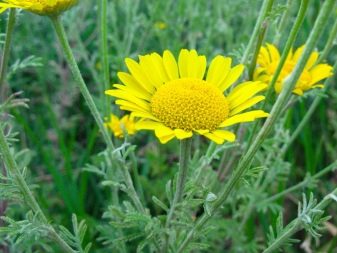
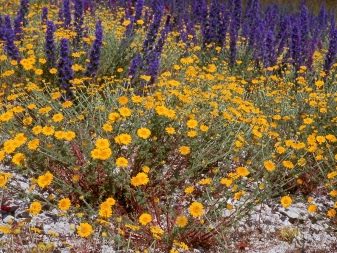
Often appears in empty areas - near the house, along roads and along the edges of large cultivated crops. Pupavka yellow-flowered has straight, abundantly branching stems, the foliage on them is wrinkled and dissected, like feathers. Leaves of a bluish-greenish tint are covered with cobweb pile, the dimensions of the pinnately dissected plate are about 1-6 cm in length and 1-2 cm in width. The underside of the foliage is covered with down and is divided into multiple segments resembling ridges, the teeth of which end in cartilaginous formations. The height of an adult plant ranges from 20 cm to 1 meter.
In the first year after planting, the anthemis does not bloom - the young plant only throws out branchy stems. Yellow chamomile can form twigs with buds only in the second year of life. The peduncles of the navel can grow from 12 to 20 cm, the peduncles themselves are bare - without leaves. On the peduncles, yellow flowers grow, collected in single baskets about 6 cm in diameter. The flowers in the basket are of two types: buds with pistils and tongues bloom at the edges, and inside - tubular and with a small corolla.
When the yellow flower fades, fruits appear in place of the flowers - smooth achenes of a dark brown hue. The boxes are shaped like oblong flattened wedges with 5 edges on both sides. Achenes are small - only about 2-2.5 mm in length, 0.7 mm in width and 0.5 mm in thickness.
The seeds begin to ripen in late August, but the belly button continues to bloom throughout September.
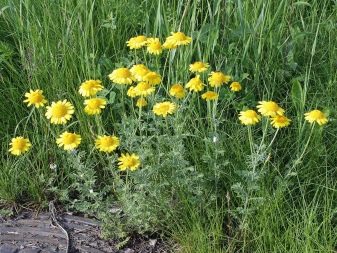
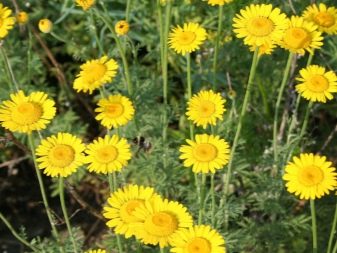
Growing conditions
Pupavnik used to be very popular due to its versatility - the plant was planted in flower beds for beauty, used in folk medicine and created yellow paint from inflorescences. Currently, antemis is usually used only for decorating local areas and in landscape design.
- Landing site. Yellow chamomile is unpretentious - it does not need any special care, so gardeners can safely forget about its existence after planting. However, there is a nuance that you need to know about before planting the yellow flower - this plant loves the sun very much. If the sun's rays are blocked by other decorative saplings (peonies, chrysanthemums, or other flowers), the stems of the navel can grow incredibly long to reach the illuminated areas. For this reason, it is better to plant shoots in open areas of land so that the anthemis grows in the form of a neat, branched bush.
- The soil. Pupavka yellow-flowered can grow on almost any garden soil, even if the soil is depleted. Soil with a small amount of nutrients is enough for a perennial plant to form a root system and release dense, low stems with inflorescences. Nevertheless, fertilizers will not be superfluous - in such a land, yellow chamomile will be able to release stronger shoots and thick baskets with many flowers. In the case when there is only sandy soil in the local area, it will become very difficult to grow an umbilical cord. In order for the plant to grow comfortably, it is necessary to prepare a suitable place - dig a hole 40-50 cm deep in the flower bed and fill it with enriched soil. In such conditions, the bushes can dry out in particularly hot weather, but this will not prevent them from releasing flowers.
- Watering. Anthemis is able to withstand serious droughts - the rain for yellow chamomile is quite enough to grow comfortably, but in especially dry periods it is recommended to water it periodically. Moderate humidity will help the umbula to discard many bluish-green leaves and to dissolve numerous flowers. Lush bushes with a scattering of bright yellow daisies look much better in a flower bed than dried stems with sluggish leaves.
- Top dressing. Pupavka dye reacts well to feeding - the bush becomes stronger, and the foliage becomes denser. For feeding, you can use biohumus fertilizer or a weak mullein solution. The plant in the first few years after planting does not need feeding if the soil is enriched with ash or fertilizers were initially laid in it.

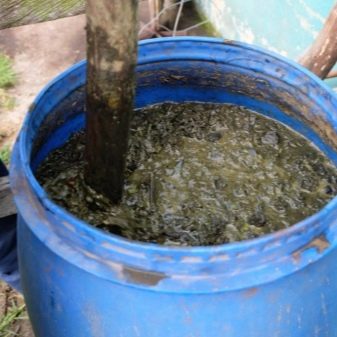
Reproduction
Pupavka dyeing is a perennial plant that can live up to 12 years, but in landscape design it is usually cultivated as a biennial. An ornamental plant is dug up and divided every two years to maintain the aesthetic appearance of the bushes. Antemis can be propagated in two ways: seed and vegetative method. Let's consider each option for flower reproduction in more detail.
- Reproduction by seeds. Pupavka is a very tenacious plant, so it is easily propagated by seeds. For this method, it is not even necessary to germinate the shoots in the greenhouse - the seeds can be sown directly into the open ground. A good time for sowing a plant in open soil is autumn and spring. Nevertheless, it is better not to sow yellow chamomile immediately into a flower bed - at first it is recommended to grow shoots in fertile soil on a separate bed and only then transplant to a permanent place.In the fruits of one anthemis, from 10 to 40 thousand seeds are formed, each of which with a high probability will be able to germinate. The seeds of this autumn flower are so good at germination that in the fields planted with crops, they treat it like a weed.
- Vegetative reproduction. This method can be used two years after the first planting of the dyeing plant in open ground. The breeding method is as simple as possible - the bushes must be dug up, divided into parts and planted at a distance of 20-30 cm from each other.
Vegetative propagation is best done in autumn.
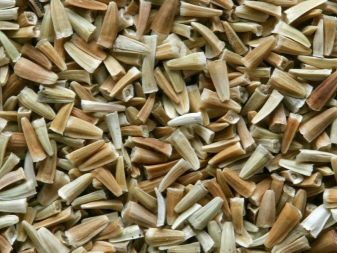
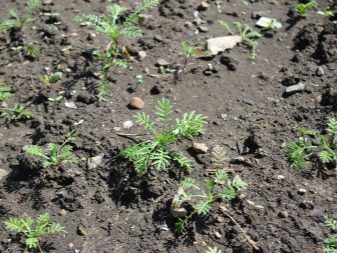
Use in landscape design
Sowing the soil with a dyeing pot is the ideal formula for landscaping a flower bed that is not hidden from the sun. The plant produces abundant self-seeding, so beautiful flowers will decorate the area near the house for almost the entire season. An unpretentious plant does not need additional care, is not afraid of frosts down to -30 ° C and is able to survive drought. Beautiful yellow flowers can be grown even by those people who absolutely do not have enough time to beautify the yard. Anthemis does not require much attention to itself - it only needs to be occasionally watered and planted every 2 years.
Pupavnik looks beautiful even in the first year after sowing, despite the fact that at this time it does not bloom. The bluish-green plant looks great in a flower bed thanks to its lush leaves that resemble ridges or feathers. Decorative sprigs of yellow chamomile are even used by florists to create beautiful bouquets. Anthemis is best combined with blue and blue flowers such as peonies, aquilegia or irises.
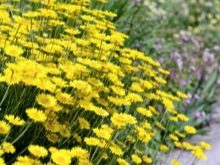

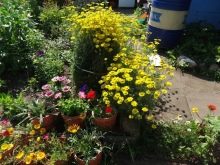







































































































The comment was sent successfully.